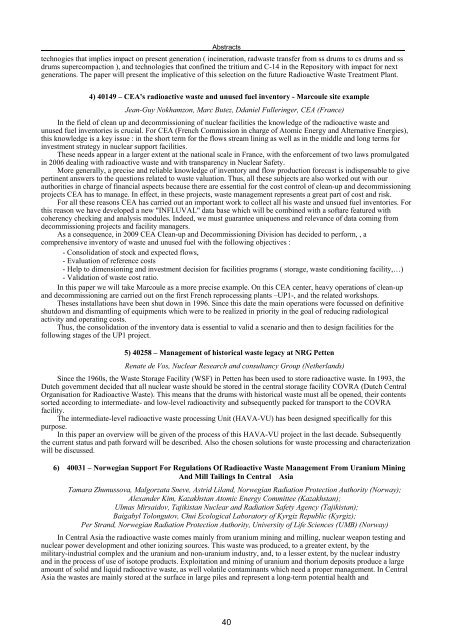The 13th International Conference on Environmental ... - Events
The 13th International Conference on Environmental ... - Events
The 13th International Conference on Environmental ... - Events
You also want an ePaper? Increase the reach of your titles
YUMPU automatically turns print PDFs into web optimized ePapers that Google loves.
Abstracts<br />
technogies that implies impact <strong>on</strong> present generati<strong>on</strong> ( incinerati<strong>on</strong>, radwaste transfer from ss drums to cs drums and ss<br />
drums supercompacti<strong>on</strong> ), and technologies that c<strong>on</strong>fined the tritium and C-14 in the Repository with impact for next<br />
generati<strong>on</strong>s. <str<strong>on</strong>g>The</str<strong>on</strong>g> paper will present the implicative of this selecti<strong>on</strong> <strong>on</strong> the future Radioactive Waste Treatment Plant.<br />
4) 40149 – CEA's radioactive waste and unused fuel inventory - Marcoule site example<br />
Jean-Guy Nokhamz<strong>on</strong>, Marc Butez, Ddaniel Fulleringer, CEA (France)<br />
In the field of clean up and decommissi<strong>on</strong>ing of nuclear facilities the knowledge of the radioactive waste and<br />
unused fuel inventories is crucial. For CEA (French Commissi<strong>on</strong> in charge of Atomic Energy and Alternative Energies),<br />
this knowledge is a key issue : in the short term for the flows stream lining as well as in the middle and l<strong>on</strong>g terms for<br />
investment strategy in nuclear support facilities.<br />
<str<strong>on</strong>g>The</str<strong>on</strong>g>se needs appear in a larger extent at the nati<strong>on</strong>al scale in France, with the enforcement of two laws promulgated<br />
in 2006 dealing with radioactive waste and with transparency in Nuclear Safety.<br />
More generally, a precise and reliable knowledge of inventory and flow producti<strong>on</strong> forecast is indispensable to give<br />
pertinent answers to the questi<strong>on</strong>s related to waste valuati<strong>on</strong>. Thus, all these subjects are also worked out with our<br />
authorities in charge of financial aspects because there are essential for the cost c<strong>on</strong>trol of clean-up and decommissi<strong>on</strong>ing<br />
projects CEA has to manage. In effect, in these projects, waste management represents a great part of cost and risk.<br />
For all these reas<strong>on</strong>s CEA has carried out an important work to collect all his waste and unsued fuel inventories. For<br />
this reas<strong>on</strong> we have developed a new "INFLUVAL" data base which will be combined with a softare featured with<br />
coherency checking and analysis modules. Indeed, we must guarantee uniqueness and relevance of data coming from<br />
decommissi<strong>on</strong>ing projects and facility managers.<br />
As a c<strong>on</strong>sequence, in 2009 CEA Clean-up and Decommissi<strong>on</strong>ing Divisi<strong>on</strong> has decided to perform, , a<br />
comprehensive inventory of waste and unused fuel with the following objectives :<br />
- C<strong>on</strong>solidati<strong>on</strong> of stock and expected flows,<br />
- Evaluati<strong>on</strong> of reference costs<br />
- Help to dimensi<strong>on</strong>ing and investment decisi<strong>on</strong> for facilities programs ( storage, waste c<strong>on</strong>diti<strong>on</strong>ing facility,…)<br />
- Validati<strong>on</strong> of waste cost ratio.<br />
In this paper we will take Marcoule as a more precise example. On this CEA center, heavy operati<strong>on</strong>s of clean-up<br />
and decommissi<strong>on</strong>ing are carried out <strong>on</strong> the first French reprocessing plants –UP1-, and the related workshops.<br />
<str<strong>on</strong>g>The</str<strong>on</strong>g>ses installati<strong>on</strong>s have been shut down in 1996. Since this date the main operati<strong>on</strong>s were focussed <strong>on</strong> definitive<br />
shutdown and dismantling of equipments which were to be realized in priority in the goal of reducing radiological<br />
activity and operating costs.<br />
Thus, the c<strong>on</strong>solidati<strong>on</strong> of the inventory data is essential to valid a scenario and then to design facilities for the<br />
following stages of the UP1 project.<br />
5) 40258 – Management of historical waste legacy at NRG Petten�<br />
Renate de Vos, Nuclear Research and c<strong>on</strong>sultancy Group (Netherlands)<br />
Since the 1960s, the Waste Storage Facility (WSF) in Petten has been used to store radioactive waste. In 1993, the<br />
Dutch government decided that all nuclear waste should be stored in the central storage facility COVRA (Dutch Central<br />
Organisati<strong>on</strong> for Radioactive Waste). This means that the drums with historical waste must all be opened, their c<strong>on</strong>tents<br />
sorted according to intermediate- and low-level radioactivity and subsequently packed for transport to the COVRA<br />
facility.<br />
<str<strong>on</strong>g>The</str<strong>on</strong>g> intermediate-level radioactive waste processing Unit (HAVA-VU) has been designed specifically for this<br />
purpose.<br />
In this paper an overview will be given of the process of this HAVA-VU project in the last decade. Subsequently<br />
the current status and path forward will be described. Also the chosen soluti<strong>on</strong>s for waste processing and characterizati<strong>on</strong><br />
will be discussed.<br />
6) 40031 – Norwegian Support For Regulati<strong>on</strong>s Of Radioactive Waste Management From Uranium Mining<br />
And Mill Tailings In Central� Asia<br />
Tamara Zhunussova, Malgorzata Sneve, Astrid Liland, Norwegian Radiati<strong>on</strong> Protecti<strong>on</strong> Authority (Norway);<br />
Alexander Kim, Kazakhstan Atomic Energy Committee (Kazakhstan);<br />
Ulmas Mirsaidov, Tajikistan Nuclear and Radiati<strong>on</strong> Safety Agency (Tajikistan);<br />
Baigabyl Tol<strong>on</strong>gutov, Chui Ecological Laboratory of Kyrgiz Republic (Kyrgiz);<br />
Per Strand, Norwegian Radiati<strong>on</strong> Protecti<strong>on</strong> Authority, University of Life Sciences (UMB) (Norway)<br />
In Central Asia the radioactive waste comes mainly from uranium mining and milling, nuclear weap<strong>on</strong> testing and<br />
nuclear power development and other i<strong>on</strong>izing sources. This waste was produced, to a greater extent, by the<br />
military-industrial complex and the uranium and n<strong>on</strong>-uranium industry, and, to a lesser extent, by the nuclear industry<br />
and in the process of use of isotope products. Exploitati<strong>on</strong> and mining of uranium and thorium deposits produce a large<br />
amount of solid and liquid radioactive waste, as well volatile c<strong>on</strong>taminants which need a proper management. In Central<br />
Asia the wastes are mainly stored at the surface in large piles and represent a l<strong>on</strong>g-term potential health and<br />
40
















